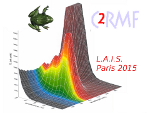In recent years, the direct application of optically stimulated luminescence (OSL) dating to rock surfaces has attracted considerable interest. In archaeology, there are many examples of rock surfaces, rock art, and stone structures whose chronology is of great importance to understanding the way in which people have used the landscape. We have recently developed a new technique of OSL dating that is directly applicable to rock surfaces. Here, we demonstrate the application of this new technique to rock samples from three different archaeological sites of different ages around the world: 1) a Rodedian prehistoric shrine from Israel, 2) a Barrier Canyon Style rock art from Utah, USA and 3) a whetstone from an Iron Age village in Denmark. The advantage of the new OSL rock surface dating technique to that of the conventional OSL sediment burial dating is that rocks can retain a record of their depositional history in their OSL-depth profiles. This allows us to recover multiple burial/exposure events in the history of our samples and, in two cases, estimate the duration of these events using known-age profiles.
|
Optically stimulated luminescence dating of rock surfaces
1 : Nordic Laboratory for Luminescence Dating, Department of Geoscience, Aarhus University & Center for Nuclear Technologies, Technical University of Denmark
|
| Online user: 1 | RSS Feed |

|

 PDF version
PDF version